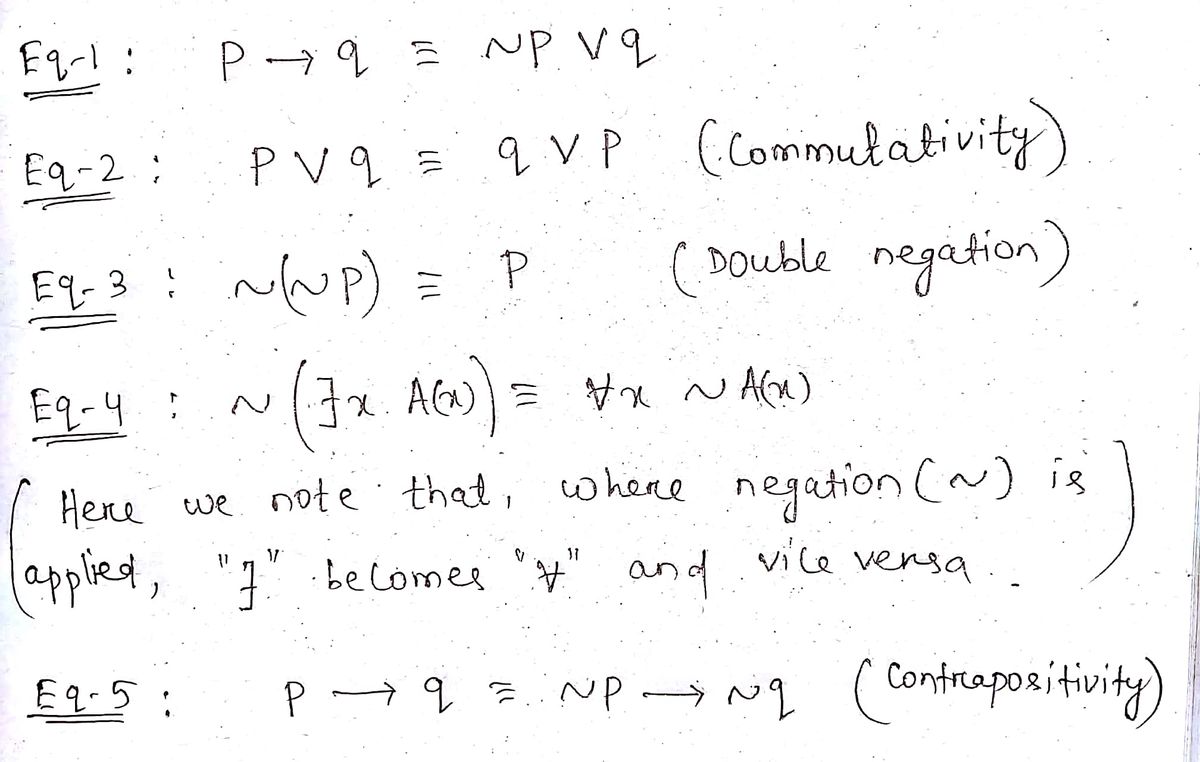Rule 7.2.9: Implication a. Vr (C → A(x)) = C → Vx A(x) b. 3x (C → A(x)) = C → 3x A(x) c. Vx (A(x) → C) = 3x A(x) –→ C d. Эx (A(г) —> C) %3D Vx A(z) — С
Rule 7.2.9: Implication a. Vr (C → A(x)) = C → Vx A(x) b. 3x (C → A(x)) = C → 3x A(x) c. Vx (A(x) → C) = 3x A(x) –→ C d. Эx (A(г) —> C) %3D Vx A(z) — С
Advanced Engineering Mathematics
10th Edition
ISBN:9780470458365
Author:Erwin Kreyszig
Publisher:Erwin Kreyszig
Chapter2: Second-order Linear Odes
Section: Chapter Questions
Problem 1RQ
Related questions
Topic Video
Question
Consider the equivalence rule 7.2.9c. Note that x does not occur free in C in this equivalence.
Prove 7.2.9c using other equivalences. That is, start with the left-hand-side of 7.2.9c, and use other
equivalences to transform the left hand side to equivalent formulas until you obtain the right-handside of 7.2.9c (or start with the right-hand-side and obtain the left-hand-side). Write down your
work step by step very clearly, stating which equivalence you are using for each step.

Transcribed Image Text:**Rule 7.2.9: Implication**
This section explains a logical implication rule, often used in formal logic or predicate logic contexts. The rule is presented with four equivalences:
a. \(\forall x \, (C \rightarrow A(x)) \equiv C \rightarrow \forall x \, A(x)\)
b. \(\exists x \, (C \rightarrow A(x)) \equiv C \rightarrow \exists x \, A(x)\)
c. \(\forall x \, (A(x) \rightarrow C) \equiv \exists x \, A(x) \rightarrow C\)
d. \(\exists x \, (A(x) \rightarrow C) \equiv \forall x \, A(x) \rightarrow C\)
**Explanation:**
- The symbols \(\forall x\) and \(\exists x\) represent universal and existential quantifiers, respectively.
- \(C \rightarrow A(x)\) denotes a conditional statement where \(C\) implies \(A(x)\).
- The equivalence symbol \(\equiv\) indicates that both sides of the equation have the same truth value.
- In each rule, quantifiers are moved across the implication with appropriate modification on the consequent or antecedent. The rules express certain conditions under which a universally or existentially quantified implication can be rewritten as an unquantified implication with the quantifier moved outside the implication. These transformations maintain logical equivalence.
Expert Solution
Some important logical equivalences.

Step by step
Solved in 2 steps with 2 images

Knowledge Booster
Learn more about
Need a deep-dive on the concept behind this application? Look no further. Learn more about this topic, advanced-math and related others by exploring similar questions and additional content below.Recommended textbooks for you

Advanced Engineering Mathematics
Advanced Math
ISBN:
9780470458365
Author:
Erwin Kreyszig
Publisher:
Wiley, John & Sons, Incorporated

Numerical Methods for Engineers
Advanced Math
ISBN:
9780073397924
Author:
Steven C. Chapra Dr., Raymond P. Canale
Publisher:
McGraw-Hill Education

Introductory Mathematics for Engineering Applicat…
Advanced Math
ISBN:
9781118141809
Author:
Nathan Klingbeil
Publisher:
WILEY

Advanced Engineering Mathematics
Advanced Math
ISBN:
9780470458365
Author:
Erwin Kreyszig
Publisher:
Wiley, John & Sons, Incorporated

Numerical Methods for Engineers
Advanced Math
ISBN:
9780073397924
Author:
Steven C. Chapra Dr., Raymond P. Canale
Publisher:
McGraw-Hill Education

Introductory Mathematics for Engineering Applicat…
Advanced Math
ISBN:
9781118141809
Author:
Nathan Klingbeil
Publisher:
WILEY

Mathematics For Machine Technology
Advanced Math
ISBN:
9781337798310
Author:
Peterson, John.
Publisher:
Cengage Learning,

